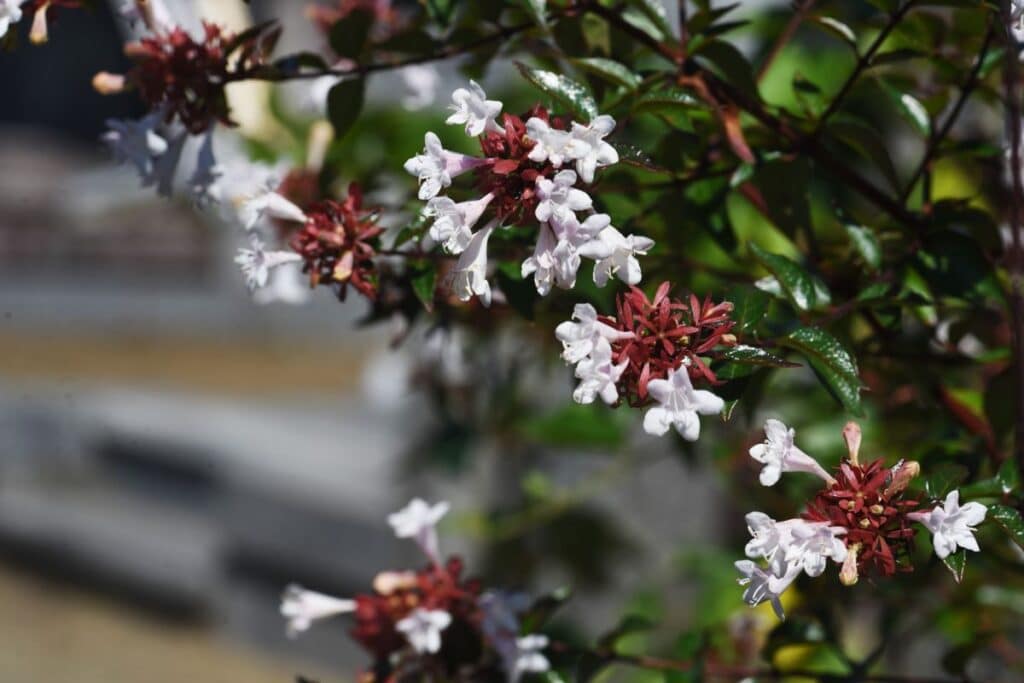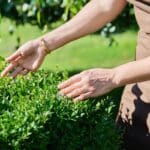Abelia (Linnaea x grandiflora), commonly known as Chinese abelia, is a beautiful ornamental shrub that is often used as hedges or mixed borders because they add lots of charm with its waxy leaves and charming white or pink flowers.
A notable cultivar, Abelia ‘Kaleidoscope’ has unique foliage colour and beautiful tones that change with each season.
Plenty of gardeners also use these plants on slopes or banks to control erosion and these flowers will also attract plenty of hummingbirds, bees, and butterflies to your garden.
These shrubs look their absolute best if you pair Abelia with other shrubs like snow-white Indian Hawthorne and heavenly bamboo or you can grow them along with other ornamental plants like maiden grass, catmint, or lily of the Nile.
Let’s take a closer look at these companions and find out how to pair them in your garden.
What to Plant with Abelia
For successful companion planting with Abelia Grandiflora, it is always best to combine these plants with other plants that have a similar growing season or growing requirement. You can learn more about abelia plant care on our website.
Abelias grow very well in any free-draining soil rich in nutrients. These plants require regular watering because they don’t like spells of drought. They do however need plenty of direct sunlight because more sun exposure will ensure lots of beautiful white or pink flowers but they can survive in dappled shade.
Let’s take a look at other plants that grow well in direct sun and nutrient-rich soil that is watered frequently.
Snow White Indian Hawthorne
Snow white Indian hawthorn (Rhaphiolepis indica) are good miss lemon abelia companion plants because the masses of white flowers of this shrub will look charming next to the multi-colored foliage of the abelia shrub.
Snow white Indian Hawthorn will flourish in well-drained soil and they need frequent watering with more regular watering during periods of extreme heat. They can be planted in full sun with some afternoon shade.
You can plant snow-white Indian Hawthorne right next to abelias to create mixed borders. Both of these shrubs are easy to trim to keep them in shape but the Hawthorne’s will stay a little bit shorter than abelia plants since they only grow up to 3 feet tall while abelias can become taller.
Maiden Grass
Maiden grass (Miscanthus sinesis) are great rose creek abelia companions because the soft grass flowers will add lots of texture to your garden bed and the reddish white color of this grass variety pairs well with the faint pink flowers of this abelia variety.
Maiden grass will flourish if planted in full sun and it takes well to various soil types including clay soil. It grows at its best in well-drained soil and prefers moist soil even though it can be drought-tolerant at times.
This grass variety can become rather tall with a maximum height of up to 8 feet tall while abelia plants typically only become 3 feet tall.
Because of its height difference, you should either position the grass variety behind glossy abelia or plant it right next to your dark green shrubs.
Heavenly Bamboo
Heavenly bamboo (Nandina domestica), also known as Nandina or sacred bamboo, are wonderful canyon creek abelia companion plants because they will add lots of color to your garden with their reddish young leaves and bright red berries.
This bamboo variety grows well in full sun but should be established in a slightly humid area with lots of protection from harsh wind. The shrub will also grow very well in light shade areas and can even tolerate deep shade. The plant is very flexible and can grow well in any soil type in USDA hardiness zones 6 – 9.
This evergreen shrub should be established in the background or it should be trimmed regularly because it can reach a height of up to 8 feet tall. Because it is so tall, it is usually best to use sacred bamboo as a background plant.
Catmint
Catmint (Nepeta cataria), also known as catnip, catswort, or catwort, is another good companion to pair with abelia plants if you want something to grow in front of these shrubs.
Catmint plants go well with Kaleidoscope Abelia in mixed borders because the silvery foliage and purple flowers of catmint will look charming next to the light green and reddish foliage of abelias.
Catmint grows well in full sun and should be planted in well-draining soil and they do prefer a slightly acidic soil type. These great companion plants are drought tolerant but will also survive with more frequent watering. You can also grow this shrub-like herb in partial shade but it won’t produce as many flowers in these conditions.
Kaleidoscope abelia grows up to 2.5 feet tall while catmint will only grow up to 10 inches tall. If you are mixing these two plants in the same garden then you should either position the catmint in the front or keep your kaleidoscope abelias trimmed to form hedges with a uniform height.
Lily of the Nile
Lily of the Nile (Agapanthus), also called African lily, are good perennials to pair with abelia plants because the tall leaves of this plant will add lots of texture next to the glossy leaves of abelia shrubs. They also produce tall spherical flower clusters that can add lots of color from early spring to late fall.
These deciduous perennials grow well in full sun position and need at least 6 – 8 hours of direct sunlight each day.
In warmer climates, they can be planted in partial shade or right next to tall abelia shrubs because those arching branches will offer a bit of needed shade. These bulb plants will take well to any hummus-rich soil with good drainage and they do prefer regular watering,
When you are using the lily of the Nile as a companion plant, you should take note that these evergreen plants take five years to fully mature. It is best to buy mature plants for your local nursery if you want instant blooms.
The leafy bulbs should be grown in front of your abelia shrubs so the abelias will create a charming backdrop that can help these semi-evergreen flowers stand out more while they are n full bloom.
What NOT to Plant with Abelia
Abelia plants are quite flexible and will add year-round color to your garden whether you plant them in full sun or shade areas. Because of their flexible nature, they can be paired with all sorts of plant species.
The plants won’t develop well in deep shade conditions which means you should avoid pairing them with deep shade species like camellias or hydrangeas. They can however grow well with these plants in dappled shade areas.
Abelias require frequent watering and will wilt and die if they are not watered often enough. As such, they shouldn’t be paired with drought-tolerant plant species like lavender, black-eyed susans, bee balm, astilbes, or other plants that prefer a little bit more drought.
Landscaping Ideas for Abelia and Companions
Now that you know a little bit more about the best companions for abelia plants, it is time to discover creative ways to pair these plants in your garden.
Here is a quick look at some of the best combination ideas.
Mixed Borders
Mixed borders are great for dividing certain parts of your garden or for creating a barrier between your lawn and garden bed. Abelias are very dense and can create great borders.
You can also mix these shrubs with other short shrubs like kaleidoscope abelia and keep their natural shape for texture-rich borders.
Hedges or Screens
Shrub plants are ideal for living screens and can be useful for hedges around properties.
Abelias can be paired with other beautiful shrubs like hawthorn to create interesting barriers that can hide away unsightly areas in your garden.
Play with Tall and Short Plants
You can pair abelia shrubs with plants of a lower height like Lily of the Nile or catmint. The taller abelias will create a striking backdrop while the shorter plant will add lots of interest around the base of these shrubs.
Container Gardens
Abelias can grow well in containers under the right conditions. If you love container gardens then you can position these tall plants in the back with other container plants like maiden grass next to them. The different colors and textures will create a charming effect in your garden.
FAQs
Does Abelia kaleidoscope like sun or shade?
Abelia ‘Kaleidoscope’ thrives in full to partial sun, showcasing its most vibrant foliage colors when exposed to direct sunlight. While it can tolerate light shade, optimal growth and the best display of variegated leaves occur in sunnier conditions.
What goes well with radiance Abelia?
Several plants complement the Radiance Abelia’s variegated foliage and late-summer blooms. For a contrasting texture and vibrant color, consider soft touch holly with its dark green, glossy leaves. Alternatively, green mountain boxwood adds a low-maintenance, formal touch while highlighting the Abelia’s delicate flowers.
Final Thoughts
Abelia plants have many practical applications in ornamental gardens. They can also be successfully paired with all sorts of beautiful plants like maiden grass, catmint, Lily of the Nile, heavenly bamboo, or Hawthorne to mix things up or add more texture to your garden. We hope that these companion plants for abelia gave you plenty of inspiration for your own garden and that you will now be able to get the most out of these beautiful shrubs.
See more:
*image by YK1500/depositphotos







